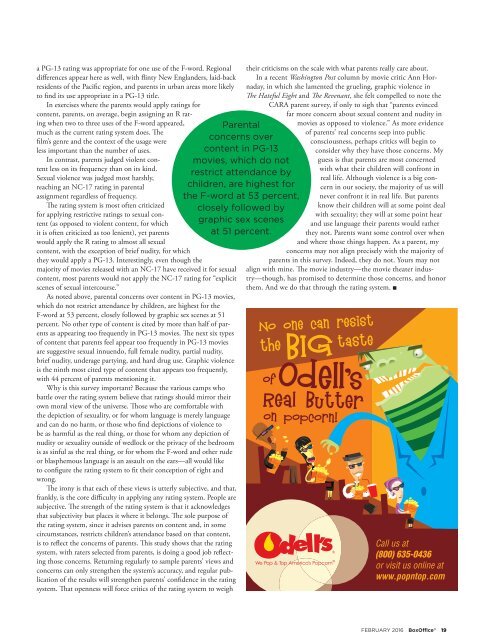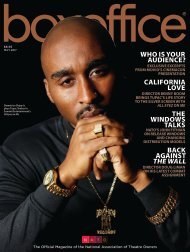Boxoffice - February 2016
The Official Magazine of the National Association of Theatre Owners
The Official Magazine of the National Association of Theatre Owners
Create successful ePaper yourself
Turn your PDF publications into a flip-book with our unique Google optimized e-Paper software.
a PG-13 rating was appropriate for one use of the F-word. Regional<br />
differences appear here as well, with flinty New Englanders, laid-back<br />
residents of the Pacific region, and parents in urban areas more likely<br />
to find its use appropriate in a PG-13 title.<br />
In exercises where the parents would apply ratings for<br />
content, parents, on average, begin assigning an R rating<br />
when two to three uses of the F-word appeared,<br />
much as the current rating system does. The<br />
film’s genre and the context of the usage were<br />
less important than the number of uses.<br />
In contrast, parents judged violent content<br />
less on its frequency than on its kind.<br />
Sexual violence was judged most harshly,<br />
reaching an NC-17 rating in parental<br />
assignment regardless of frequency.<br />
The rating system is most often criticized<br />
for applying restrictive ratings to sexual content<br />
(as opposed to violent content, for which<br />
it is often criticized as too lenient), yet parents<br />
would apply the R rating to almost all sexual<br />
content, with the exception of brief nudity, for which<br />
they would apply a PG-13. Interestingly, even though the<br />
majority of movies released with an NC-17 have received it for sexual<br />
content, most parents would not apply the NC-17 rating for “explicit<br />
scenes of sexual intercourse.”<br />
As noted above, parental concerns over content in PG-13 movies,<br />
which do not restrict attendance by children, are highest for the<br />
F-word at 53 percent, closely followed by graphic sex scenes at 51<br />
percent. No other type of content is cited by more than half of parents<br />
as appearing too frequently in PG-13 movies. The next six types<br />
of content that parents feel appear too frequently in PG-13 movies<br />
are suggestive sexual innuendo, full female nudity, partial nudity,<br />
brief nudity, underage partying, and hard drug use. Graphic violence<br />
is the ninth most cited type of content that appears too frequently,<br />
with 44 percent of parents mentioning it.<br />
Why is this survey important? Because the various camps who<br />
battle over the rating system believe that ratings should mirror their<br />
own moral view of the universe. Those who are comfortable with<br />
the depiction of sexuality, or for whom language is merely language<br />
and can do no harm, or those who find depictions of violence to<br />
be as harmful as the real thing, or those for whom any depiction of<br />
nudity or sexuality outside of wedlock or the privacy of the bedroom<br />
is as sinful as the real thing, or for whom the F-word and other rude<br />
or blasphemous language is an assault on the ears—all would like<br />
to configure the rating system to fit their conception of right and<br />
wrong.<br />
The irony is that each of these views is utterly subjective, and that,<br />
frankly, is the core difficulty in applying any rating system. People are<br />
subjective. The strength of the rating system is that it acknowledges<br />
that subjectivity but places it where it belongs. The sole purpose of<br />
the rating system, since it advises parents on content and, in some<br />
circumstances, restricts children’s attendance based on that content,<br />
is to reflect the concerns of parents. This study shows that the rating<br />
system, with raters selected from parents, is doing a good job reflecting<br />
those concerns. Returning regularly to sample parents’ views and<br />
concerns can only strengthen the system’s accuracy, and regular publication<br />
of the results will strengthen parents’ confidence in the rating<br />
system. That openness will force critics of the rating system to weigh<br />
Parental<br />
concerns over<br />
content in PG-13<br />
movies, which do not<br />
restrict attendance by<br />
children, are highest for<br />
the F-word at 53 percent,<br />
closely followed by<br />
graphic sex scenes<br />
at 51 percent.<br />
their criticisms on the scale with what parents really care about.<br />
In a recent Washington Post column by movie critic Ann Hornaday,<br />
in which she lamented the grueling, graphic violence in<br />
The Hateful Eight and The Revenant, she felt compelled to note the<br />
CARA parent survey, if only to sigh that “parents evinced<br />
far more concern about sexual content and nudity in<br />
movies as opposed to violence.” As more evidence<br />
of parents’ real concerns seep into public<br />
consciousness, perhaps critics will begin to<br />
consider why they have those concerns. My<br />
guess is that parents are most concerned<br />
with what their children will confront in<br />
real life. Although violence is a big concern<br />
in our society, the majority of us will<br />
never confront it in real life. But parents<br />
know their children will at some point deal<br />
with sexuality; they will at some point hear<br />
and use language their parents would rather<br />
they not. Parents want some control over when<br />
and where those things happen. As a parent, my<br />
concerns may not align precisely with the majority of<br />
parents in this survey. Indeed, they do not. Yours may not<br />
align with mine. The movie industry—the movie theater industry—though,<br />
has promised to determine those concerns, and honor<br />
them. And we do that through the rating system. n<br />
FEBRUARY <strong>2016</strong> BoxOffice ® 19

















